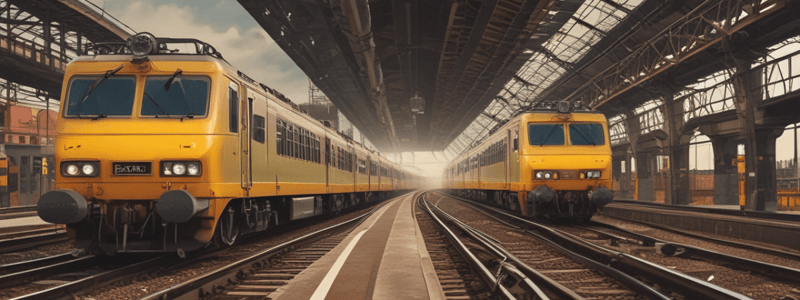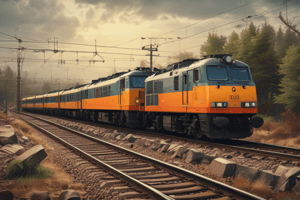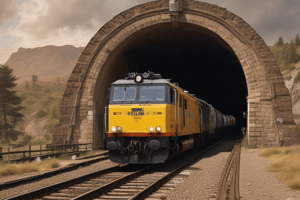Podcast
Questions and Answers
What is the maximum vertical wear allowed for a 60 kg/m rail section?
What is the maximum vertical wear allowed for a 60 kg/m rail section?
- 10.00 mm
- 8.00 mm
- 13.00 mm (correct)
- 6.00 mm
Where is the lateral wear measured on a rail?
Where is the lateral wear measured on a rail?
- 13 to 15 mm below the rail top table (correct)
- 20 mm below the rail top table
- 5 mm below the rail top table
- 10 mm below the rail top table
What is the speed in km/h after the 3rd day's events?
What is the speed in km/h after the 3rd day's events?
- 110
- 30
- 75
- 40 (correct)
What is the lateral wear limit for 'C' & 'D' Routes in curves?
What is the lateral wear limit for 'C' & 'D' Routes in curves?
What is done on the 1st day?
What is done on the 1st day?
Why may renewals be necessary on a track?
Why may renewals be necessary on a track?
What is the purpose of superimposing the worn rail profile over the new rail profile?
What is the purpose of superimposing the worn rail profile over the new rail profile?
What happens on the 5th day?
What happens on the 5th day?
What is the lateral wear limit for 'A' & 'B' Routes in curves?
What is the lateral wear limit for 'A' & 'B' Routes in curves?
What is the speed on the 2nd day?
What is the speed on the 2nd day?
What is the maximum vertical wear allowed for a 52 kg/m rail section?
What is the maximum vertical wear allowed for a 52 kg/m rail section?
What happens on the 10th day?
What happens on the 10th day?
Why is it necessary to maintain a track to prescribed standards?
Why is it necessary to maintain a track to prescribed standards?
What is the speed on the 9th day?
What is the speed on the 9th day?
What happens on the 6th day?
What happens on the 6th day?
What is done on the 7th and 8th days?
What is done on the 7th and 8th days?
What is the length of the free rail in meters?
What is the length of the free rail in meters?
What type of sleepers should be used for both running lines and yard lines?
What type of sleepers should be used for both running lines and yard lines?
What type of rail will be used in non-running lines of yards?
What type of rail will be used in non-running lines of yards?
What is the purpose of classifying released material?
What is the purpose of classifying released material?
How should the rails be graded after a section of track has been renewed?
How should the rails be graded after a section of track has been renewed?
What should be done to the rail-ends that are worn or hogged?
What should be done to the rail-ends that are worn or hogged?
What should be done to the sleepers after a section of track has been renewed?
What should be done to the sleepers after a section of track has been renewed?
What is done to the welds in short rails during track renewal?
What is done to the welds in short rails during track renewal?
What should be done to Fish-plates, fish-bolts, ERCs, and Liners?
What should be done to Fish-plates, fish-bolts, ERCs, and Liners?
What should be done to badly worn switches and crossings?
What should be done to badly worn switches and crossings?
What is Class I Material?
What is Class I Material?
What is included in Class II Material?
What is included in Class II Material?
What is Class II (a) rail used for?
What is Class II (a) rail used for?
What is included in Class III Materials?
What is included in Class III Materials?
Why are some new items of obsolescent sections brought on to the stock account as Class I Material?
Why are some new items of obsolescent sections brought on to the stock account as Class I Material?
What is done to small fittings like stretcher bars, switch anchors, stud-bolts and blocks if the switches and crossings are badly worn?
What is done to small fittings like stretcher bars, switch anchors, stud-bolts and blocks if the switches and crossings are badly worn?
When is the relaying work considered complete?
When is the relaying work considered complete?
What is the purpose of temporary strengthening of gangs?
What is the purpose of temporary strengthening of gangs?
What is the purpose of description boards?
What is the purpose of description boards?
When should the permanent way diagrams be revised?
When should the permanent way diagrams be revised?
Who should be advised about the revised permanent way diagrams?
Who should be advised about the revised permanent way diagrams?
What should be updated in the TMS?
What should be updated in the TMS?
When should the accounts for relaying works be closed?
When should the accounts for relaying works be closed?
What should be submitted with the closed accounts?
What should be submitted with the closed accounts?
Flashcards are hidden until you start studying
Study Notes
Rail Wear and Maintenance
- Typical rail wear profile shows vertical wear limits of 13.00 mm for 60 kg/m rail section and 8.00 mm for 52 kg/m rail section.
- Lateral wear limits are 8 mm for 'A' & 'B' routes and 10 mm for 'C' & 'D' routes in curves, and 6 mm for 'A' & 'B' routes and 8 mm for 'C' & 'D' routes in straight tracks.
- Lateral wear measurement is taken at 13 to 15 mm below the rail top table.
Maintainability of Track
- Track maintenance requires renewals based on poor running quality, disproportionate maintenance costs, or other considerations.
- A sequence of events is followed for track maintenance, including ballasting, tamping, stabilisation, and surveying.
Machine Packing and Stabilisation
- Machine packing followed by stabilisation is used for mechanised laying of track.
- The sequence of events includes opening, relaying, and equalisation of ballast, followed by welding, tamping, and stabilisation.
Sleepers and Rails
- Concrete sleepers are used for both running lines and yard lines.
- Class II rail is used for non-running lines in yards.
- Short welded panels of 3 rail length may be used for through rail renewals or complete track renewal in yards.
Classification and Use of Released Material
- Released material is classified into Class I (new material), Class II (new material of obsolescent sections or used material fit for further use), and Class III (unserviceable material).
- Class II material is sub-divided into Class II (a) for use in running lines and Class II (b) for use in non-running lines.
- Fish-plates, fish-bolts, ERCs, and liners are sorted into reusable and scrap materials.
- Switches and crossings are reconditioned by welding if the wear is not excessive.
Temporary Strengthening of Gangs and Revision of Permanent Way Diagrams
- After relaying, regular maintenance gangs are temporarily strengthened to maintain the track to the required standard.
- Permanent Way diagrams are revised to reflect the new track materials and details.
- The revised diagrams are updated in the Divisional office and headquarter, and advised to all concerned.
Studying That Suits You
Use AI to generate personalized quizzes and flashcards to suit your learning preferences.




